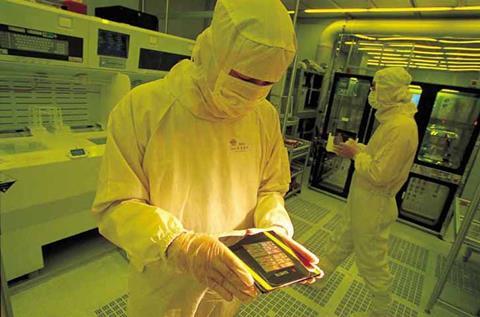The semiconductor shortage is hitting automotive production around the world and that disruption is going to continue into 2022. Senior research analyst for Gartner, Pedro Pacheco, spoke to Automotive Logistics about the ongoing semiconductor shortage and what OEMs need to do to cope with it

The automotive industry is preparing for extended assembly disruption because of the semiconductor shortage. The latest industry analysis predicts that the impact on production will last beyond this year and into 2022.
The rapid increase in sales of consumer electronics during the Covid pandemic, combined with the accelerating digitalisation of workplaces, means semiconductor production is struggling to meet demand. Added to which, the automotive industry is still fighting to regain its share following shutdowns that only temporarily curtailed demand but cancelled orders.
Companies are setting out strategies to stabilise and reorient production to avoid future turbulence. For the automotive sector, that involves becoming more focused and in control of the latest technology being used in the vehicles they are assembling, including the digital software running systems in the car and the hardware on which it is running.
“The microchip crisis, together with the transformation that’s been happening to the automotive sector prior to this crisis, are turning these companies more tech-centric and [putting them] more in control of the software, which will lead them ultimately to have greater control over the hardware,” said Pedro Pacheco, senior research analyst for analyst firm Gartner. He also noted that it was the carmakers with greater size and financial power to effect this change that would be able to manage the crisis in the long term.
Pacheco said the first step for the OEMs will be to build closer relationships with chip manufacturers. Currently, the OEMs don’t have direct contract with the subcomponent makers on the tier three or four level, but that will become a crucial element in the near future. He stressed that proximity to the chipmakers meant a better chance of getting the best hardware.

“OEMs differ in the level of performance desired. Some want to get to the point of designing their own microchips, and this is already starting to happen with Samsung and Tesla, which means more control.” Pacheco said.
Some companies are looking to improve communications regarding chipmakers’ production allocation and establish closer partnerships through joint ventures (something Toyota and Denso were looking at with their Mirise joint venture prior to the current crisis, to take another example).
Channels of communication
Better communication is the basis for any future strategy designed to avoid the disruption to production the automotive business has suffered over the last year. However, that communication has got to be focused on long-term strategies and not just short-term fixes.
“You’re not going to solve the capacity problem in the short term, which means this year,” he said, adding that OEMs were firefighting the current situation with mitigation. “You can try different channels to reach out to chipmakers, sometimes even governments involved,” he explained.
Companies have been also looking at innovative ways of reducing their dependency on chip-heavy mechanisms amid the shortage.
Pacheco said that companies were reviewing the mix in terms of vehicle production and assessing how many microchips there were allocating to particular model variants
“They will say, ‘we can’t source those, so let’s produce another variant instead of producing this one’. In some cases, with a particular feature that requires microchips, one may decide to not use that feature,” he noted.
“French PSA was moving from digital instrument pinnacles to analogue because, in the end, it was the way to sell a car, and if it doesn’t have digital instrument pinnacles, then tough luck. It’s one way to move forward.”
The monopoly problem
One of the main structural problems with the semiconductor supply chain is that multiple parts makers and OEMs depend on a very small number of microchip producers, Intel, TSMC and Qualcomm are three of the biggest.
Pacheco told Ultima Media that producers are now attempting to invest in large diversification projects to break this dependency.
“A considerable amount of money is being invested into this sector [and] therefore, shortage of demand means opportunity [to grow],” Pacheco said.
Microchip manufacturers or intermediaries are investing in wafer fabrication, a key production process in making semiconductors and chips. This will boost capacity but it takes three or four years to get a wafer fabrication facility (fab) up and running.

Pacheco explained that a number of governments in the US and the EU are trying to set up strategic initiatives to bring microchip production to the region. It is currently mainly focused in South-East Asia.
An inherent instability
Greater localisation of semiconductor and wafer suppliers means OEMs can avoid the sort of disruption that hampers long distance, global supply chains. However, it is important to remember that disruption can also happen locally. Pacheco said it wasn’t a case of one or the other but that diversifying the source of supply was the best way forward, stressing the importance of what he described as “real resiliency” or flexibility on supply and manufacturing. Unfortunately, many manufacturers are not as flexible as they would like to be.
Foresight is also an important factor, he said. This includes having the capability or visibility to grasp problems at the very beginning.
“This is the other problem that many supply chains have,” said Pacheco. “They are slow in reacting or do not understand the complexity of a problem.”
When the Covid pandemic hit automotive sales and production last year, carmakers and tier suppliers rushed to cancel orders for microchips. The simultaneous increase in consumer electronic meant the automotive sector then went to the bottom of the priority list and lost order slots.
“If companies had the right foresight, they would have seen that production was actually going to pick up again and they didn’t need to cancel anything… it’s about building that foresight,” he said.
In the wake of the 2011 Fukushima earthquake in Japan, carmakers, including Toyota built in mitigation and business continuity measures to secure and restore supply and operations.
He said that, so long as a company is willing to pay for it, creating a safety stop like Toyota following the Fukushima reactor failure in 2011 is actually quite easy even you can afford it. Building a strong culture of data exchange and analytics into that will ultimately make a company or production region more resilient.
“When something happens at one point in the chain, there’s a snowball effect, knocking down all the dominos until it hits you,” warned Pacheco, adding that earlier access to information permits an earlier reaction.
Digital solutions
General Motors is another carmaker using technology to build in resiliency. It is introducing an industrial cloud system across all of its plants, with the eventual goal of integrating its entire network. Pacheco said that building a more robust supply chain it did not just stop at the cloud.
Every link in the supply chain has to be using similar data standards and the same language,” he said, adding that there also needs to be an IT architecture that allows that data to flow easily from organisation to organisation. According to Pacheco, the ecosystem needs to be prolific in collecting data and he said any IT framework is dependent on the ability to effectively collect and process that data.
“If you set up a fantastic IT architecture that everyone is connected to and shares similar standards buy you don’t [effectively] collect the data then it doesn’t work,” he said.
Pacheco also explained that further communication between different companies would allow chip producers to align their processes.
“You need to get a lot of companies into the same picture, and you need alignment between companies,” he said. “It’s not new that you have OEMs trying to build greater fluidity in terms of data exchange with their suppliers. The problem is that if OEM A wants to work one way and OEM B wants to do it another way, if you’re a tier one supplier then you’re wondering ‘what should I do?’“

Learning from other industries
As mentioned, the semiconductor shortage has not just hit the automotive industry. Many sectors reliant on microchips have felt the heat, in particular those involved in the production of personal computing and mobile phones. Is it, therefore, possible for carmakers to look elsewhere for inspiration?
“Tech is very different as it’s about software. Automotive is about building cars. So, it’s hard to get that comparison,” Pacheco said. “But in terms of manufacturing, automotive is already one of the most advanced industries.”
One comparison he identified between the automotive and technology industries is the commonality of digital ecosystems. Both are used to connecting several different devices that were not produced by the same company but are nevertheless brought under the same ecosystem. That allows for a lot in terms of functionalities, features and efficiencies, according to Pacheco.
He stressed that the automotive industry would need to put aside its instinct to be defensive against competitors and look towards partnerships with them, including in the technology sector.

























![Global[1]](https://d3n5uof8vony13.cloudfront.net/Pictures/web/a/d/s/global1_726550.svgz)













1 Reader's comment